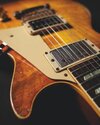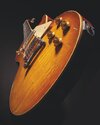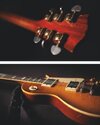Gehört einem Herrn Page.
Er schreibt dazu:
I was temporarily living in Miami, Florida and
@joewalshofficial was playing at the Gulfstream Park racetrack. Joe’s an old friend and our connection goes back to some of the American dates from my Yardbirds days. He was in the James Gang, based in Cleveland, and he’d come and see us whenever we were in town. He is a really nice man and I enjoyed his company.
Back then, Joe brought a Les Paul Standard along to a Fillmore East gig on the first leg of the American tour and said, ‘You’ve got to have this guitar.’ I said, ‘Well, I don’t need it, Joe, I’ve got a Les Paul Custom.’
I knew that Les Paul guitars were very user-friendly, insomuch as they put out a lot of level when you plugged them into the amplifier because they had a double-coil pickup, whereas the Telecaster had a single-coil pickup. With the sort of volume that I now needed to put out in live situations, although I was using controlled feedback, I found that the Telecaster was starting to squeal a bit.
I had to be very careful about where I was standing because of the unsympathetic feedback.
With the Les Paul you’d get feedback through the amp and speakers, but you could control it more easily and work with it. You could actually change the literal note and frequency that was coming back on the feedback. I just really enjoyed playing Joe’s guitar, and so I agreed with him that maybe I should buy his Les Paul Standard after all.
I played the Les Paul on Whole Lotta Love and What Is and What Should Never Be and that decided it for me: it was definitely going to be the Les Paul from then on. I always wanted to make a change for each album sonically and that was my first decision for Led Zeppelin II.
Like I had built Led Zeppelin around the Fender Telecaster, I built the second album around the sonic texture of the Les Paul Standard. Neither Joe Walsh nor I realised at the time just what an important thing he had done by coming along with that Les Paul.



 .
.

 Wie heißt es so schön... die Schönheit liegt im Auge des Betrachters:
Wie heißt es so schön... die Schönheit liegt im Auge des Betrachters:




 )
)